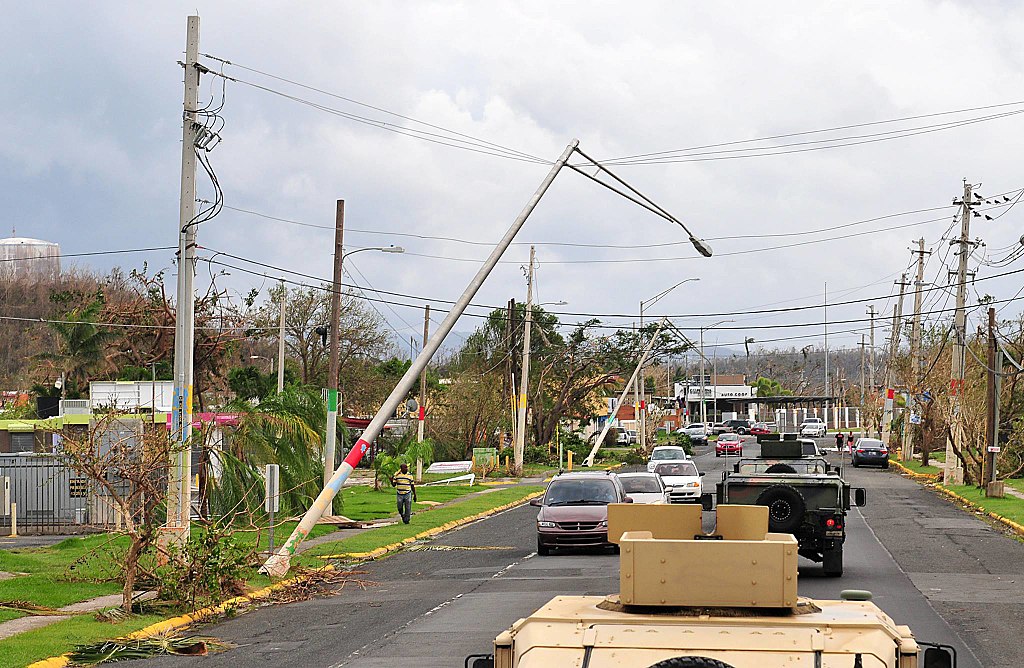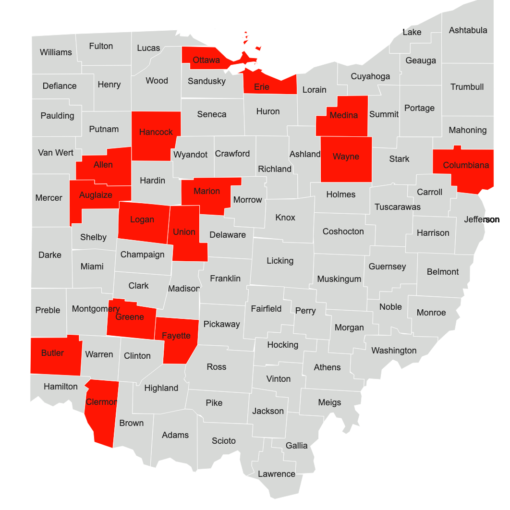By Romany Webb

Nearly three weeks after being hit by Hurricane Maria, 90 percent of Puerto Rico remains without electricity. While the island’s nine key generating facilities were not seriously damaged by Maria, they cannot be used, as the infrastructure required to transfer electricity to customers no longer exists. The Puerto Rico Electric Power Authority (PREPA) estimates that Maria destroyed eighty percent of the island’s electricity transmission infrastructure and nearly 100 percent of its distribution infrastructure. Rebuilding this infrastructure will be a major undertaking, particularly since new transmission lines will need to be constructed through Puerto Rico’s mountainous interior, to connect generating facilities on its southern coast with population centers in the north. According to some officials, it could be up to six months before the system is rebuilt, and electricity is restored.
With pressure mounting for immediate action, on September 28, the Army Corps of Engineers was put in charge of rebuilding Puerto Rico’s electric grid. Rebuilding will be funded primarily, if not entirely, with federal money appropriated by Congress. As my colleague, Justin Gundlach, recently reported, past appropriations acts have been interpreted as requiring federal money to be used solely to rebuild what was lost (i.e., without any improvements). That doesn’t make a lot of sense in the age of climate change, however. With storms expected to become more frequent and severe, we must “build back better,” so as to increase resiliency to future disasters. Puerto Rico’s electric system, for example, should be rebuilt in a way that reduces reliance on centralized generation necessitating long-distance transmission of electricity. In doing so, the Commonwealth can learn from the experiences of other islands, such as Cuba, which has increased its disaster resiliency by making greater use of distributed energy resources (DERs).
DERs are small-scale generating, storage, and other technologies installed at scattered locations on or near customers’ premises. The most common example is solar photovoltaic systems, which may be installed on customers’ rooftops, and used to meet on-site electricity demand, or export electricity to the grid. (Incidentally, in a forthcoming report, Justin Gundlach and I explore reforms needed to facilitate greater DER participation in wholesale electricity markets in the mainland U.S.) Tesla-founder Elon Musk last week suggested that such systems, combined with battery storage, could be deployed throughout Puerto Rico. This would have a number of advantages over continuing to rely on centralized generation. Most importantly, as DERs are located close to customers, their use reduces the potential for system outages due to transmission line failures (e.g., as a result of hurricanes or other disasters).
As well as lessening the impact of future disasters, expanding the use of DERs in Puerto Rico may also reduce the risk of such disasters occurring, by helping to mitigate climate change. Puerto Rico’s centralized generating facilities are currently a major source of climate-damaging greenhouse gases. This is primarily due to their extensive use of fossil fuels, which continue to account for 98 percent of generation. By far the largest fuel source is oil, which accounts for 47 percent of electricity generation, followed by natural gas, accounting for 34 percent of generation, and coal, accounting for 17 percent. This results in significant carbon dioxide and other greenhouse gas emissions, with a 2015 report on Puerto Rico’s electricity generating sector finding that just two facilities (one oil-fired and one coal-fired) had annual emissions of seven million metric tons of carbon dioxide equivalent, more than the entire state of Vermont.
In recent years, the U.S. mainland has been able to reduce greenhouse gas emissions from electricity generation, by making greater use of renewable energy sources. In Puerto Rico, however, the use of renewables has stagnated at just two percent of total generation. The legislature tried to change that by adopting a renewable portfolio standard (RPS) – set at 12 percent in 2015, rising to 15 percent in 2020, and 20 percent in 2035 – and directing PREPA to demonstrate compliance by purchasing renewable energy certificates. Unfortunately however, PREPA missed the 2015 target by ten percentage points, and is widely expected to miss the 2015 target, likely by an even greater margin.
PREPA’s failure to meet the RPS is primarily due to its precarious financial position – the utility was $9 billion in debt before it filed for bankruptcy in July 2017 – and does not reflect a lack of renewable resources in Puerto Rico. On the contrary, according to a recent study by the National Renewable Energy Laboratory, the island has enough solar and wind energy resources to meet over half of peak demand. Developing large-scale generating facilities to utilize these resources may prove difficult due to the limited amount of available land in Puerto Rico. Smaller distributed facilities would, however, be easier to deploy and have the added benefit of increasing the Puerto Rico’s resiliency to climate change. While PREPA is not in a position to invest in distributed generation, such investment could be funded by Congress, as part of the Hurricane Maria relief package.
The need to rebuild Puerto Rico’s electric grid in the wake of Hurricane Maria provides a unique opportunity to transition to more distributed generation. A similar situation arose in Cuba in 2004, when a series of hurricanes hit the island’s eastern side, destroying its transmission infrastructure and leaving one million people without electricity. Keen to avoid a similar situation in the future, in 2006, the Cuban government embarked on “La Revolución Energética” (the Energy Revolution) aimed at “creat[ing] a new energy culture for sustainable development.”
A key goal of Cuba’s Energy Revolution was to “complement the [island’s] large central power plants with distributed generation.” The Cuban government invested heavily in distributed generation, funding the construction of thousands of facilities, which were installed throughout the island. As a result, Cuba now has the second highest rate of distributed generation globally (after Denmark), obtaining 40 percent of its electricity from distributed generating facilities. Although half of the facilities are diesel generators, Cuba is transitioning to more renewable generation, with the government providing significant funding for solar photovoltaic systems. This has enabled the installation of 8,000 systems, with a combined capacity of 2.6 megawatts, nearly four times that of Puerto Rico. Hopefully, Congress will provide the funding Puerto Rico needs to catch up, and increase its resiliency to future disasters.
Romany Webb is a Research Scholar at Columbia Law School, Adjunct Associate Professor of Climate at Columbia Climate School, and Deputy Director of the Sabin Center for Climate Change Law.




